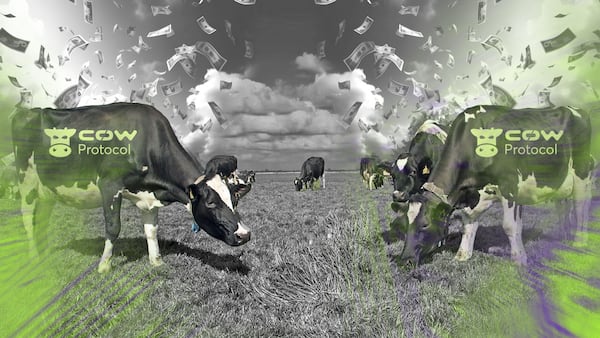- CoW Protocol is launching a new AMM to protect liquidity providers from MEV bots.
- The new AMM will force arbitrage bots to bid on the right to rebalance liquidity pools.
- CoW AMM will provide the biggest benefit to those who provide liquidity for less popular asset pairs.
Liquidity providers are vital to the $68 billion DeFi ecosystem. These DeFi users put up their tokens in so-called liquidity pools to facilitate trading in exchange for a small fee.
But providing liquidity — or LPing — is mired with risks. Impermanent loss can occur when the balance of tokens in a pool changes, rendering tokens worthless for LPs. And then there are so-called MEV bots that can decrease profits and even result in long-term losses for those providing liquidity.
CoW DAO, the developer cooperative behind the decentralised exchange CoW Swap, wants to make things easier for liquidity providers. It just launched a new so-called automated market maker — or AMM — to combat MEV bots and hopefully save liquidity providers an estimated $500 million every year.
“There has been an active academic discussion on the topic for at least a year now,” Alex Marsh, a core contributor to CoW DAO, told DL News. “We do not know of any other teams working on this.”
AMMs — exchanges that use liquidity pools rather than market order books to facilitate trades — are currently the most popular way to trade tokens in DeFi. Top decentralised exchange Uniswap uses an AMM model.
MEV bots: a double-edged sword
MEV stands for maximal extractable value. It refers to the potential value that can be generated by reordering transactions within blockchain blocks. Almost all MEV is carried out by lightning-fast bots.
MEV bots provide a valuable service by arbitraging onchain price differences and creating more efficient DeFi markets. But many kinds of MEV are also harmful to traders and liquidity providers alike. Bots can front-run transactions to buy assets before another trade bumps up the price.
Sandwich attacks — an advanced form of front-running — are one of the most common types of MEV.
Here MEV bots scan the Ethereum network for users buying a token and then jump the queue and place a large order ahead of them, bumping up the price. After the victim’s trade is processed, increasing the price further, the bot sells the tokens for a new higher price.
A June report from investment firm Galaxy Digital estimates that MEV bots have extracted between $300 million and $900 million from traders on Ethereum using these strategies.
According to CoW DAO, the amount liquidity providers specifically lose to MEV bots is more than that lost in front-running and Sandwich attacks combined.
Loss-versus-rebalancing
CoW DAO’s new AMM aims to protect liquidity providers from MEV bots by eliminating something called LVR — or loss-versus-rebalancing.
LVR refers to the losses LPs incur due to arbitrage MEV bots taking advantage of stale prices in liquidity pools. By rebalancing pools, bots earn a small profit and make prices more competitive for traders — but at the expense of liquidity providers.
According to CoW DAO, liquidity providers for major token pairs earn 5-7% less than they should due to LVR.
To remedy the discrepancy, CoW DAO’s new AMM will force arbitrage bots to bid on the right to rebalance liquidity pools. This ensures that arbitrageurs are still incentivised to rebalance pools, but also lets the protocol return the majority of the profits back to liquidity providers.
“This is the most desirable model but also the hardest to implement as it relies on setting up a competitive bidding market,” Marsh said. “Fortunately the CoW Protocol has this already.”
An academic paper published in November compared current AMM models to the bidding system used in CoW AMM. The results of six months of backtesting showed that LP returns on CoW AMM would have been equal to or greater than returns on Uniswap in 10 of the 11 most liquid, non-stablecoin pairs.
According to Marsh, CoW AMM will provide the biggest benefit to those who provide liquidity for less popular asset pairs more than those who do it for popular ones like stablecoins.
“Stable-to-stable liquidity pools offer fewer attack vectors for arbitrage bots, and tend to make more from fees than they lose to LVR,” he said.
Stiff competition
CoW AMM is not CoW Protocol’s first product. In 2021, the collective launched CoW Swap, a product that facilitates peer-to-peer token swaps and helps traders dodge MEV bots.
While CoW Swap has garnered a loyal following, and facilitated over 34.8 billion in trading volume, it is still an order of magnitude away from Uniswap, the leading decentralised exchange with over $2 trillion worth of trades.
Although CoW AMM will be the first of its kind to be deployed, there’s little to stop other exchanges launching similar products in the future. Those with a greater share of the decentralised exchange market may be able to outcompete CoW DAO, despite its head start.
CoW DAO’s competitors may even be working on their own solutions already. “We wouldn’t be surprised if other teams are exploring other types of LVR solutions, given the scale of the problem,” Marsh said.
Tim Craig is DL News’ Edinburgh-based DeFi Correspondent. Reach out with tips at tim@dlnews.com.







